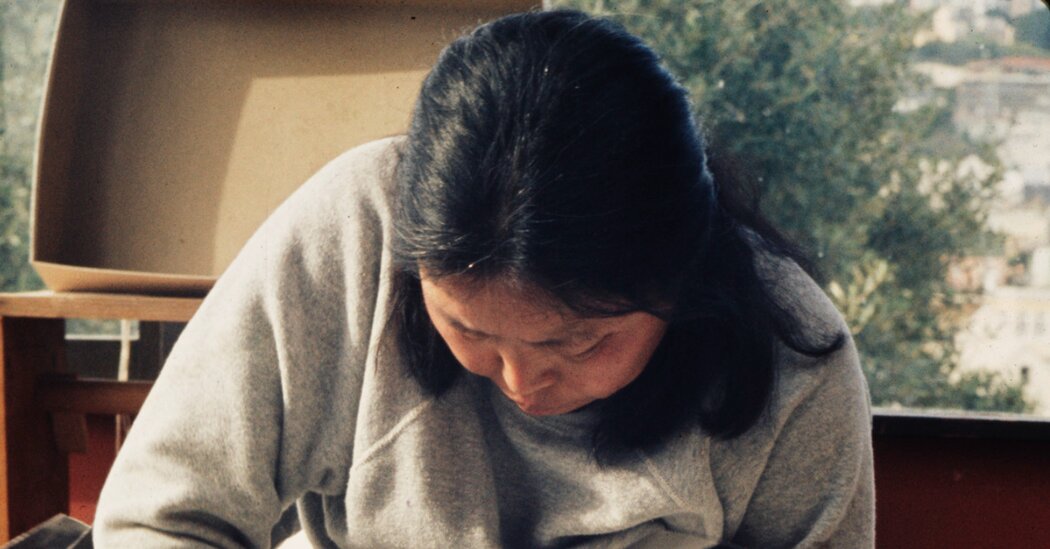A meandering stroll is a thing of leisure. But the meander is also a decorative pattern of repeated sharp turns — which makes it a good metaphor for the career of Ruth Asawa.
A modernist sculptor acclaimed — perhaps mistakenly — for her work’s quietude, Asawa wove sublimely delicate hanging forms out of nested lobes of looped wire. Celebrated early — and then politely ignored — they have been increasingly visible over the past decade, with good cause. But they are only a fraction of her output. Chasing the intersection of solid form and thin air, Asawa was dedicated above all to drawing, and her works on paper are illuminated by a revelatory exhibition opening at the Whitney Museum on Saturday.
The meander showed up early in her graphic work, in a jazzy composition from the late 1940s, its short passages of interlocking waves constructed from cut colored paper. In another drawing of the same period, in black and red ink and graphite, meanders of various sizes hurry back and forth in text-like rows, as if genially arguing the balance of line and shape, positive and negative form.
Drawing was important from the start. Born in 1926 to Japanese parents, she was raised on a truck farm in Southern California, and, like her six siblings, toiled alongside them picking vegetables for market. Hard work and traditional culture were strongly valued: the children were sent to Japanese school on Saturdays, where Asawa first practiced calligraphy, with well-remembered relish. Her childhood effectively ended with wartime internment, first at the Santa Anita raceway, where most of the family was quartered in a scarcely converted horse stable (Asawa’s father was separately imprisoned), and next in a camp in Arkansas. Difficult (and sometimes miserable) conditions deepened established habits of industriousness and resilience. Also insomnia. Being awake to the world was always, it seems, imperative.
Anti-Japanese prejudice survived the war, and prevented Asawa from securing the work experience she needed to complete a degree in teaching. A blessing in disguise, the rejection led her instead to continue her education at the legendary Black Mountain College, where her most influential teachers were Josef Albers — she took 10 of his classes in all — and Buckminster Fuller. Both mixed design, geometry and art in their teaching, and both became Asawa’s lifelong friends. “When he talked about art he talked about equality,” she recalled of Albers, adding, “you could either be involved in visual problems of equality on the page,” or “interpret it as his way of talking about living.”
If the stakes were high, the practice was stringent. Exhorting his students to explore ordinary materials such as paper, wire and string, Albers paired an aesthetic inclination with habits of thrift already deeply instilled in Asawa. Formal economy and practical frugality, shared hallmarks of many Depression-era Modernists, are also standard practice in vernacular craft traditions around the world. Asawa, shaped by both, made her second trip to Mexico during a summer break from Black Mountain, learning to weave wire baskets from local artisans. She took the technique to sculpture on her return.
Settling in San Francisco in the late 1940s with her husband, Albert Lanier, an architect she had met at Black Mountain, Asawa found favor for her wire sculptures from interior designers as well as art dealers. By the early 1950s her sculpture was also being shown in New York, at the Peridot gallery, where gallery mates included Louise Bourgeois and Constantin Brancusi; their precariously footed, totemic work had a kinship with Asawa’s. But she itched to push her drawings forward. “Working in wire was an outgrowth of my interest in drawing,” she often insisted. Offered a show in 1959 at the de Young Museum in San Francisco, she asked that it focus exclusively on graphic work, and was turned down; the request and denial were repeated at Peridot.
A long time coming, then, the exhibition at the Whitney is a treasure. Organized jointly with the Menil Foundation (where it will appear next) and curated by Kim Conaty and Edouard Kopp, it skews early, emphasizing the period from the late ’40s through the ’70s (Asawa died in 2013), and vividly demonstrating her inventiveness. The rubber stamp Black Mountain used for marking its laundry shows up in a number of lively prints; there are also impressions of inked leaves, and an imposing inked fish. Asawa was not above making use of children’s art materials, as in a buoyant magenta and orange potato print from the early 1950s. But neither was she committed to age-old traditions. Some particularly engrossing drawings were made with modified felt-tip pens; grooving the tip doubled each stroke. One such drawing from the early 1960s perfectly captures the rhythms of choppy water. A felt-tip rendering of a bentwood rocker repeats the chair’s contours to the edge of the sheet, yielding a dizzying image as unstable as its subject.
One revelation of this exhibition is the folded paper reliefs from the early 1950s. Using a technique based in origami, Asawa painted the folded facets black or white — geometric patterns shift as one moves. Morphing from harlequin diamonds to zigzag stripes to checkerboards, their eye-popping power steals a march on Bridget Riley. Op-ish, too, are a pair of brightly colored “Logarithmic Spiral Squares” screenprints, which anticipate textile design of the following decade. Another surprise is a dark-colored tin screen pinpricked with the contours of a many-petaled flower; set into a wall in front of a window, and backlit, it makes a dramatic conclusion to the exhibition.
Asawa returned to the study of calligraphy in the mid-1950s under the tutelage of a Buddhist priest, absorbing lessons reflected in ink and watercolor drawings. She described brushwork as a breathing exercise, and a kind of dance. The disciplined spontaneity she learned is evident in subsequent colored ink or watercolor drawings, picturing a eucalyptus grove, an expanse of water, or handfuls of fruit or flowers, all gloriously luminous and free.
“Forms Within Forms” and “Growth Patterns” are two of the show’s eight thematic categories. A sectioned redwood trunk and the spiraling leaves of a head of endive are among the subjects; there are also drawings that predict or document the sculptures. Quiet and careful, they feel like the show’s nerve center. (Three sculptures are on view, one of the suspended variety, another from a series of starburst shaped, tied-wire wall-works.)
Friends and family say Asawa never stopped drawing, that her hands were always moving. Clearly, she didn’t stop when they visited. A deft, tender sketch shows the photographer Imogen Cunningham fingering her pearls, her mouth open, conversationally. The artist Noah Purifoy is caught on the phone, the grip of his hand a semaphore for the intensity with which he’s listening. Perhaps the most dazzling portrait is a felt-tip-pen drawing of her son Paul as a baby, his plump white form nearly lost on a big, busily patterned quilt. Sound asleep, he seems literally held by the drawing.
As her children — there were six — entered school, Asawa became increasingly involved with art education, launching a volunteer-run art program in 1968 that by 1975 was in 40 schools. Further arts advocacy put her in touch with cultural leaders in San Francisco and beyond. During the years when the New York art world heard little of her, Asawa was very busy.
Her time was also consumed by a considerable body of public art, including a 1968 bronze fountain for Ghirardelli Square involving two mermaids (one nursing a baby, assembled from life casts of a friend) along with sea turtles, lily pads and frogs. It would be forgivable to call it sentimental. A second fountain for the plaza in front of a Hyatt hotel in San Francisco was (in today’s terms) crowdsourced, its scenes of local life shaped by around 100 nonprofessional makers working with “baker’s clay” (flour, water and salt) in Asawa’s studio.
Her last major figurative bronze was a similarly collaborative 1994 Japanese American Internment Memorial outside the Federal Building in San Jose, Calif. A prodigious gardener as well as an inveterate community-builder, Asawa also anticipated urban farming as art, communal food service as art. Referring to the Hyatt fountain involving collectively assembled elements, she explained, “Since we have no real folk art or craft tradition any more in this country, this kind of activity has to be recreated to bring families and communities together.”
While Asawa’s public efforts are touched on in the fine exhibition catalog, and explored further in a lively biography by Marilyn Chase, they have not led her remarkable renaissance. What has is a renewed belief that art, craft and the decorative arts have highly permeable — perhaps negligible — boundaries. While Asawa declined (despite precarious finances) an early offer to produce her wire sculptures commercially, she was happy to have them featured in magazines from Vogue to Domus.
Reinvigorated interest in the fiber arts movement of the 1960s and in handmade feminist art of the ’70s confirm some of the connections that Asawa’s work drew on, and fortified. The steadily growing outpouring of attention her sculpture has drawn over the last two decades reflects an embrace of art that defeats boundaries between décor, design and sculpture. Asawa’s works on paper are a field map for her restless and irrepressibly generous vision.
Ruth Asawa Through Line
Sept. 16 through Jan. 15, 2024, the Whitney Museum of American Art, 99 Gansevoort Street, Lower Manhattan; (212) 570-3600; whitney.org.


